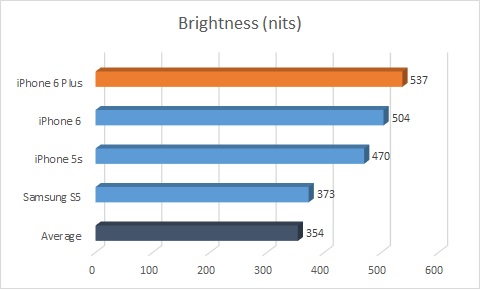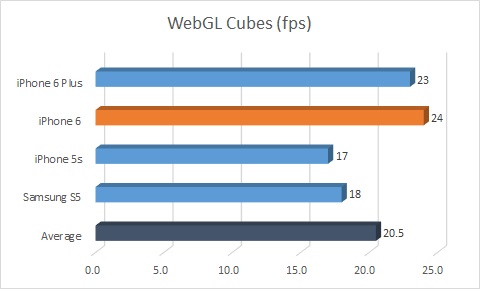iPhone 6 Benchmarks: Here's How Good It Really Is
We measure the performance of the iPhone 6 and 6 Plus display, CPU, graphics and more. Here's how it stacks up against the iPhone 5s and Galaxy S5.

Whether you're waiting expectantly by the front door for the UPS driver to arrive with yours or you're just thinking about getting one, people have a lot of questions about the iPhone 6 and 6 Plus. Are the displays brighter and more colorful? Is the A8 chip really that much faster? And how about graphics performance?
You're also probably wondering how the iPhone 6 and 6 Plus stack up not only to the iPhone 5s but Samsung's Galaxy S5. We put all four phones through a battery of tests to find out just how good Apple's new smartphones perform against the competition.
Display
Brightness

One thing's for sure: The displays on the new iPhones are BRIGHT. We measured the iPhone 6 at 504 nits, and the iPhone 6 Plus at a retina-searing 537 nits, which blows away the Galaxy S5 (373 nits) as well as the iPhone 5s (470 nits). The next-closest Android phone was the international version of the HTC One M8, which hit 498 nits.
MORE: iPhone 6 and 6 Plus Battery Life - How Long They Last
Color Gamut

Brightness is one thing, but how many colors are the iPhones capable of showing? Not as much as the competition, it turns out. The iPhone 6 Plus could only display 95.3 percent of the sRGB color gamut, and the iPhone 6 hit 96.8 percent. To be fair, those aren't bad numbers, but the iPhone 5s managed 98.4 percent.
The S5 was able to display a whopping 158.4 percent of the gamut. Numbers above 100 percent aren't necessarily better in this case, as the Samsung displays more oversaturated colors. It's more a matter of preference.
Color Accuracy

One area where the iPhone 6 and the iPhone 6 Plus definitely fall short of their peers --and predecessor -- is in color accuracy. With respective Delta-E scores of 3.6 and 1.9 (numbers closer to 0 are better), the displays aren't as accurate as the Samsung S5 (0.9) or the iPhone 5s (0.05). Still, they bested the smartphone average (4.9) by a fair margin.
Get instant access to breaking news, the hottest reviews, great deals and helpful tips.
Audio

Despite their larger size, we didn't find much of a difference in the audio output of the iPhone 6 and 6 Plus compared to the iPhone 5s. When measured from a distance of 13 inches, the iPhone 5s was slightly louder, at 82 decibels, compared with 81 dB for the iPhone 6 and 78 dB for the iPhone 6 Plus. All three were louder than the S5 (73 dB).
Performance
Apple is making a big deal about the A8 chip inside the iPhone 6 and 6 Plus, which promises a 25 percent boost in CPU performance and up to a 50 percent graphics improvement.

On Geekbench 3, which measures overall performance, the new iPhones scored markedly higher than the previous generation A7 CPU in the iPhone 5s, and put them a par with the Samsung Galaxy S5's 2.5-GHz Snapdragon 801 CPU with 2GB of RAM.

When it came time to load N.O.V.A 3, however, all three iPhones were on roughly equal footing, taking about 4.6 seconds to load the first-person shooter. All three were about three times as fast as the S5.

On Peacekeeper, which measures browser performance, Safari on the iPhone 6 Plus proved the best with a score of 2,608. The iPhone 6 came in second, at 2,565, and the iPhone 5s followed with a score of 2,265. When we ran the test using Chrome on the S5, it scored a much lower 753.

When we ran the Sunspider Javascript test, the iPhone 6 Plus again proved fastest with a time of 356.4ms (lower is better). The iPhone 6 was right on its heels with a time of 358.2ms, followed by the S5's time of 407.5ms. The iPhone 5s came in last at 430.9 ms.
Graphics
Watching HD videos and playing games constitutes a lot of what people do on their smartphones, so having a strong graphics processor is essential. Fortunately, the new iPhones are up to the task.

On the synthetic benchmark 3DMark Ice Storm Unlimited, the S5 blew past all of Apple's devices with a score of 18,204. The iPhone 6 Plus scored 16,965, while the 6 scored 16,558, and the 5s notched 14,259.

However, other graphics tests painted a different story. On the WebGL Cubes Experiment, which renders 150,000 cubes lit by three sources, the S5 averaged only 18 frames per second, just barely better than the iPhone 5s (17 fps) and less than the 6 (24 fps) and the 6 Plus (23fps).

We saw a similar delta when running GFXBench. On the Manhattan test, which measures OpenGL ES 3.0 performance, the iPhone 6 Plus scored 31.6 frames per second, the 6 hit 30.1 fps, and the iPhone 5s scored 24.3 fps. The S5 came in last, at 11.7 fps.

When also ran the Manhattan 1080p offscreen test, which uses the same 1080p resolution on every device. The iPhone 6 Plus still came out on top with a score of 18.7 fps. Next was the iPhone 6 (17.8 fps), the iPhone 5s (12.9 fps) and the Samsung S5 (11.9 fps).
Summary
That's a quick look at how the iPhone 6 and the iPhone 6 Plus compared to the Samsung Galaxy S5 and the iPhone 5s. The S5 displays more of the color gamut, but Apple's smartphones are by and large much brighter. In general, Apple's newest handhelds also outperform the S5 on many tests, making them the more powerful devices.
The most crucial test--one we're running this weekend--is battery life. The iPhone 5s lasted just 5 hours and 46 minutes on the Laptop Mag Battery Test (Web surfing via LTE), which was well below the S5's runtime of 9 hours and 42 minutes. How will the iPhone 6 and the iPhone 6 Plus compare? Stay tuned.
UPDATE: We've run our battery tests on both the iPhone 6 and iPhone 6 Plus.

Michael A. Prospero is the U.S. Editor-in-Chief for Tom’s Guide. He oversees all evergreen content and oversees the Homes, Smart Home, and Fitness/Wearables categories for the site. In his spare time, he also tests out the latest drones, electric scooters, and smart home gadgets, such as video doorbells. Before his tenure at Tom's Guide, he was the Reviews Editor for Laptop Magazine, a reporter at Fast Company, the Times of Trenton, and, many eons back, an intern at George magazine. He received his undergraduate degree from Boston College, where he worked on the campus newspaper The Heights, and then attended the Columbia University school of Journalism. When he’s not testing out the latest running watch, electric scooter, or skiing or training for a marathon, he’s probably using the latest sous vide machine, smoker, or pizza oven, to the delight — or chagrin — of his family.
-
bcongl How about running this same test against Lumia 1520. I am sure the outcome would be far different :-) .Reply -
zetabrand This really is a remarkable phone. Everyone is touting about it's "inferior specs", but it really is amazing what Apple does with them. I'm a big fan of both markets, and appreciate them both for what they do well. I would say Apple did a fine job with the 6 here, especially after holding one in my hands.Reply -
strfle Considering my Macbook Pro (Gen 3) Ivy Bridge i7 2.3 ghz with 16 gigs of Ram 1600mhz and SSD did SunSpider in 219.8ms Chrome and 181.7ms Safari plugged in.Reply
An iPhone doing it at 356 ms is pretty amazing. Clearly, phones have caught up with desktop browsing speeds. Safari on the iphone 6 feels amazing. Running online javascript Google Maps feels like a native app on iPhone 6. This is exciting for hybrid apps and what they can do soon. -
razor512 One of the main areas where apple is doing the right thing, is with their CPU, they are still focusing on better single threaded performance which is why they are doing so much better than everyone else in single threaded tasks such as web browsing.Reply
Even if you do not like apple, the CPU in their iphone is one area where you cannot really fault them.
(if you have a quad core CPU in your smartphone, run a program like android tuner if you are rooted, you will see how little those extra cores are used unless you play a number of games from some of the major developers) -
Fr3DD13 There's a mistake in the Sunspider Javascript results.Reply
The graphic shows that iPhone 6 outperformed the 6 Plus. But the text points out the contrary. -
bmwzimmer What is the brightness set at during the battery test? I hope you are setting them both at say 250 or 300 nits rather than run both at their max brightness when one is so much brighter and therefore capable of consuming more battery power.Reply -
impy1980 Where's the HTC M8, LG G3 and OnePlus One in there, all better than Samsung's S5! A test to make the iPhone look better perhaps?Reply -
truthaboutU ummm comparing the iphone to s5 is not fair....especially since the s5 is not the best android phone out....of course iphone has a faster graphics processor than the S5...the S5 doesn't even have a graphics processor....lol what a poorly researched ad..nits...what the hell are nits...how about pixels... anyway...Samsung makes the retina display for apple so I doubt they would give them a better screen than a Quad HD display on the S5....GTFOHReply -
mprospero @bmwzimmer - we set the brightness on the battery test at 150 nits on all phones. I'll be putting up a post shortly about how the iPhones did on battery life. @impy1980 - I only compared it to the S5 because it's the most popular Android phone. I'll add comparisons with the others in the full review.@truthaboutU - nits is a measure of brightness.Reply
